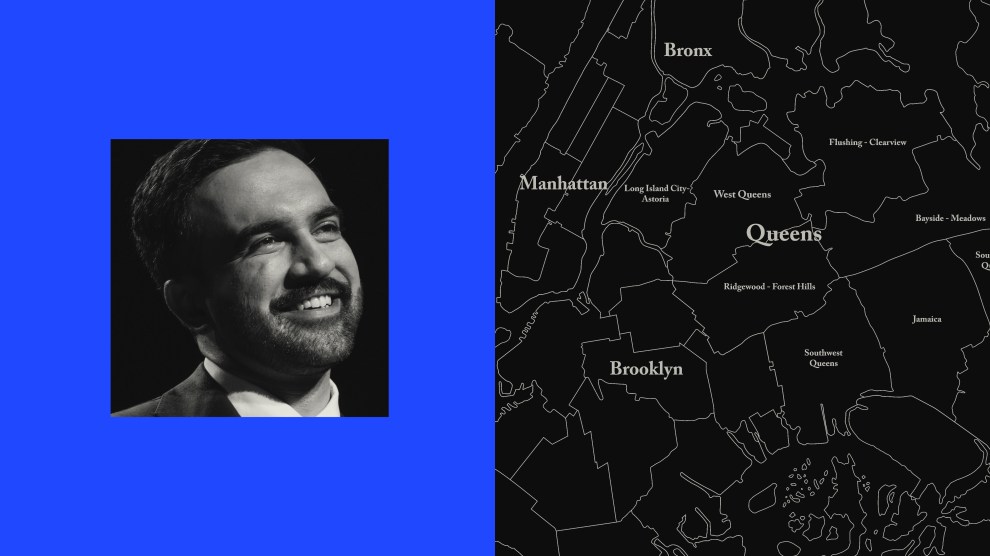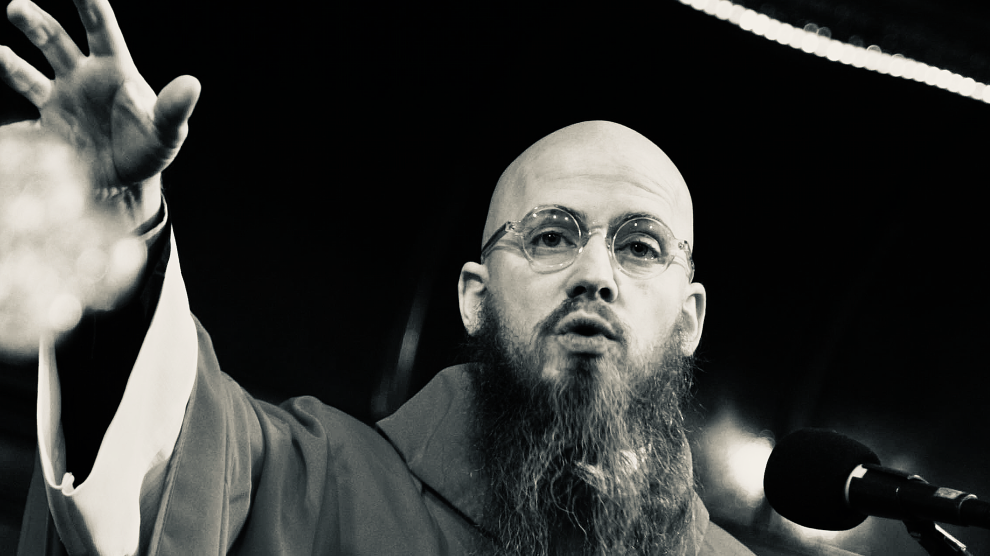
Image: Richard Thompson
A special Mother Jones series profiling American politicians
It was California Gov. Pete Wilson’s moment in the national klieg light and the high point of his failed 1996 presidential campaign: July 20, 1995, the day last summer when he killed affirmative action at the University of California, the nation’s premier public higher education system.
Although the marathon 12-hour meeting by the UC Board of Regents featured impassioned testimony by dozens of witnesses, its outcome was foreordained. Wilson had lobbied enough votes among his fellow board members to guarantee the session would be essentially a stage show for his courtship of the angry white male as Wilson sought to boost his faltering presidential bid.
On camera, Wilson was cool. But off camera, he raged. After UC Berkeley Chancellor Chang-Lin Tien publicly corrected his misuse of a stage-prop chart, a furious Wilson confronted Tien. When university officials refused to allow anti-affirmative action backers of the state’s upcoming “Civil Rights Initiative” in the press room, Wilson’s people brought one in anyway, who fed press releases to the 300 reporters present until he was discovered and evicted late in the day.
In the end, the regents of the nine-campus UC system voted 14-10 to end affirmative action in admissions and 15-10 to end affirmative action in hiring.
The Rev. Jesse Jackson was on hand to brand Wilson the “new George Wallace” for his efforts. Completing the Alabama imagery, Jackson played Martin Luther King Jr., marching at the beginning and at the end of the meeting amid a throng singing “We Shall Overcome.”
But Pete Wilson isn’t Wallace, just as Jesse Jackson isn’t King. And despite the profound backlash taking place against nonwhites in the state, California is not the South.
Something different is going on in California, which Jesse Jackson doesn’t grasp. When asked why so much racial division is coming from this historically liberal state, he dodged the question. When pressed, Jackson mumbled. He had no answer.
That night, Jackson led some 300 people on a long march through the streets of San Francisco, a meager number for a city where protest is often embraced for its own sake. At the march’s end, Jackson announced, “Tonight, the movement has been reborn.”
Civil rights lawyer Eva Paterson, who’d taken part in the march, disagreed. “No one came out,” she says. If people in a city as liberal as San Francisco wouldn’t march for affirmative action, who would?
Earlier in the day, Paterson had scolded Gov. Wilson in public testimony, reminding him of the inconvenient fact that for his entire political life, up until the previous few months, he’d supported affirmative action. In the preceding four years, he’d signed 24 bills that included it. Unlike Wallace, Wilson’s racial politics seem to be a matter of convenience.
“I know you don’t believe this,” Paterson told Wilson, “but you’ve become the symbol of racism in the United States.”
At the time, it seemed that pushing the race button was all Wilson would have to do to pave his way to the presidency. When his campaign crashed two months later, California Democratic Party Campaign Adviser Bob Mulholland was quick to crow that Wilson’s approach had been repudiated. But Democrats shouldn’t rejoice. Even though Wilson is out of the presidential race, the politics he represents will do much to define the national debate on racial issues.
Wilson’s bid for the presidency had numerous problems. He was spurned by his usual financial backers (who may have been tapped out after giving $27 million to his race for governor only one year earlier), raising less than $4 million for his presidential campaign. His polling numbers in California were disastrous, with Republicans as well as Democrats upset that he broke a promise not to run for president. Earlier in the year, he was handicapped by throat surgery that left him nearly mute for weeks. Even after he recovered, his notoriously uncharismatic persona failed to energize a national audience.
But Wilson was–and still is–a perfect mirror for the racial fears of white voters. This trait has served him particularly well in California, where polls show that voters are ready to approve an initiative, proposed for next year’s general election, to end all state affirmative action. Other presidential contenders may choose to dance to Wilson’s divisive tune as they vie for the state’s 54 electoral votes.
(In fact, Wilson’s departure from the race may have put him in a decent position for the vice presidential spot. There has been widespread speculation that should fellow Republican “moderate” Bob Dole receive the presidential nomination, he might pick up Wilson to increase his chances of carrying California in the general election.)
A man so dull his speeches send even stalwart Republicans lurching for a triple espresso, Pete Wilson seems an unlikely symbol for American racism. At age 62, Wilson’s boyish looks have faded into Bushesque pastiness. His suits appear stolen from the rack of a 1947 Iowa accountants’ convention. “Pete appears dull,” says former San Diego Councilman Floyd Morrow. “He has learned to embalm anything that moves by a huge amount of words. It’s part of his technique.”
But Wilson’s bland, dated demeanor conceals a virulent–and distinctly modern–form of political thought on race. For the past three decades, California has had a profound and growing influence on the politics of race in America. The Golden State isn’t any more or less racist than the rest of the nation, but it is setting a trend, as it has with everything from health food to Rollerblades.
At the heart of California’s racial politics is demographics. Whites will fall below half of California’s population sometime between 1998 and 2002, and they fear a commensurate loss of power. The left and the media, in California and elsewhere, consistently underestimate the depth of this fear, which blows east like a bad Pacific storm. Whites in California still account for eight out of 10 voters, and their anxiety intensified after the 1992 Los Angeles riots, when Wilson started to shed the last of his “moderate” Republican label to become the cheerleader of an electoral rebellion against “others.” Last year, the state led the national movement against immigration with the passage of the anti-Latino Proposition 187, and now it’s going after affirmative action.
The state’s reactionary laws aren’t being approved by conservatives alone. In 1994, three out of five voters approved Proposition 187 and three out of four voted for draconian “three-strikes-and-you’re-out” legislation that sentences even small-time offenders to life in prison. In 1996, the same kind of lopsided margins could end all state affirmative action programs with the Orwellspeak “California Civil Rights Initiative” scheduled for the November ballot.
While the traditional Atlantic view of race is still mostly binary (black vs. white), the Pacific coast presages America’s multiracial future, with splits between Asians, Latinos, blacks, and whites. And it’s not just whites vs. everyone else. Class is also a major factor. Wilson is supported by many overclass Asians; a significant number of Latinos (one in five favored Proposition 187 that punished illegal immigrants); and a small number of blacks.
And despite its liberal image, California has always been a leader in attacking non-African brown-skinned people. Californians hounded the Chinese in the mid-1800s, leading to the Exclusion Act of 1882. They persecuted the Japanese after the turn of the century and again during World War II. There also have been movements against Filipinos and Mexicans. When California starts whacking minorities, race-baiters from the Atlantic side of the country eagerly join the rumble. Now, however, the stakes are higher. Latinos will surpass blacks nationwide as the largest minority after 2010; by 2050, the country will be barely half white.
Wilson has been chiseling in the dark mine of fear that was El Dorado for Richard Nixon and Ronald Reagan, both of whom had political roots in California. Theirs was a racial message tailor-made for the suburbs. Bear in mind that Barry Goldwater and George Wallace won almost exclusively deep South states. Nixon and Reagan, soft-pedaling a “Wallace-Lite” version of the same message, triumphed.
Reagan first mastered the wedge issue after the 1965 Watts riots when he ran for governor. Overt racism wouldn’t work in California’s white suburbs, so Reagan masked his message with reason, using now-familiar “get-tough-on-crime” rhetoric to cater to white fear. Nixon, a California native, used anger about forced school busing, without making whites feel like Southern racists.
Of course, Republicans across the nation have copied Nixon and Reagan’s use of the racial wedge issue. What’s new about Wilson is how he upped the ante. His forebears never directly attacked programs such as affirmative action. (Reagan, for example, relied on appointing Supreme Court judges who’d carry out his wishes; the fruits of this approach are now apparent.)
But in Nixon and Reagan’s time, the country wasn’t ready for a frontal assault. Now it is. And even as Wilson engaged in one, his approach was an extension of the Nixon-Reagan style. Take immigration. As his campaign spokesman Dan Schnur pointed out, “Throughout Pete Wilson’s discussion of the illegal immigration issue, we have gone to extraordinary effort to make sure the race or ethnic origin of an individual is not an issue.”
True. Wilson never said “Mexicans.” But the television commercial Wilson used in New Hampshire, aimed at voters in the state’s February 1996 primary, didn’t show the hundreds of thousands of Europeans and Canadians who overstay their visas to remain here illegally–it showed a “banzai run” border crossing by Mexican illegals.
This hasn’t always been Wilson’s line. Once known as a moderate, even progressive, Republican, he was strongly pro-affirmative action and immigration. (His critics have made much of his pro-immigrant stands during his eight years in the U.S. Senate; in fact, Wilson supported amendments to the 1986 Immigration Reform and Control Act that eventually allowed an estimated 1 million Mexican agricultural workers to enter the country.)
But to term his recent switches “flips,” as some of Wilson’s former opponents have, is to miss a central point: Wilson never had a core belief to have flipped from. Wilson is chameleon man, a human lizard clinging to the nation’s Pacific wall. And Republican candidates anxious to pick up the California vote are paying close attention to Wilson’s changing political colors.
Like many Californians, Peter Barton Wilson was born elsewhere, in suburban Chicago. He went to Yale and then joined the Marines, which brought him west. In 1959, Wilson enrolled at the institution where he’d later launch his campaign against affirmative action–the University of California. He studied at Berkeley’s law school, then almost tuition free.
After graduating and passing the bar (on his fourth try), Wilson moved to San Diego to be near his hero, Richard Nixon. There, he worked as an advance man for Nixon’s unsuccessful 1962 bid for California governor. After becoming head of the San Diego Republican Central Committee, Wilson was elected to the state Assembly in 1966.
“In the first five years, he was among the most progressive of the freshman Republicans in my class,” says Assemblyman John Vasconcellos, who entered office at the same time.
When Wilson was elected mayor of San Diego in 1971, he protected wetlands and fought developers. More significantly, he forced the city and its contractors to hire minorities.
LaQuita Robbins, an anti-poverty activist who was among the city’s first affirmative action hires, describes an event at which Wilson arrived in his “beat-up old Chevrolet” and helped her wash glasses in the kitchen when they ran out in the middle of the meeting. “As fast as I was washing them, he was taking them back out.”
Cleo Kearse, another community activist hired by the city, recalls an event where Wilson “ate all my barbecued pigs’ feet and he wanted some more. He got real black that time.”
Before Wilson, Robbins says, about the only nonwhites employed by the city of San Diego rode on the back of garbage trucks. “Wilson was an angel here in that period. He was devoted to women’s rights and equal opportunity. I wouldn’t know him anymore.”
Robbins and Kearse agree on the moment Wilson changed: in 1972, when the Republican National Convention, set for San Diego, was abruptly switched to Miami. There were several reasons, among them the fear of anti-war protests.
Wilson took the decision personally, says Susie Davenport, also one of Wilson’s first minority hires. “He was angry. He figured that the liberal Pete that we knew was no longer going to make it to where he wanted to go. Minorities simply could no longer help him accomplish his goals. All of a sudden we could do nothing right. Everything changed.”
Gone was the old Chevy; Wilson showed up at events in a chauffeured car. “There is no real Pete,” Davenport adds. “He was never anybody.” She believes Wilson’s dropping out of the presidential race is not his final act. “Everybody seems to be jumping on his bandwagon about affirmative action. Pete has provided a way out for white America.” Just like his hero Nixon, Davenport sees Wilson staging a comeback. “He’s dead, but he’s going to keep trying.”
Like the ghoul from the Friday the 13th movies, Wilson is the Jason of politics: The prognosis is often six feet under but he routinely claws his way out of the soil. In the 1994 governor’s race against Kathleen Brown, he was 23 points behind at one point, then won with 55 percent of the vote. In 30 years, he’s only lost one race out of 11 and has never been out of office.
Wilson’s decision to bow out of the presidential race early gives him time to regroup for his next battle, whether it be as the ’96 Republican vice presidential nominee or as a presidential candidate in 2000. Either way, when Wilson returns to the national stage, he’ll depend again on racial wedge issues. His mantra for 1996 had four parts: affirmative action, immigration, crime, and welfare–all code words for race–and he’s sure to repeat the formula.
In decades past, California politicians called Mexicans “wetbacks,” and Asians “gophers” and “locusts.” Now these invectives are replaced with Wilson favorites like “quotas” and “tribalism,” which trigger the same response without broadcasting obvious racism.
California, through Wilson, is at the forefront of the old, European America rejecting the new, multiracial America, says Antonio Gonzalez, president of the Southwest Voter Research Institute. Eventually, he believes, the old America will learn “the ultimate values are the same.” But until this occurs, says Gonzalez, “I see the next political period as one of real conflict. But it will be a long fight. This is a marathon. And demographic forces are on our side.”
Dale Maharidge teaches journalism at Stanford University and is writing a book about cultural change in California to be published by Times Books in late 1996.

















